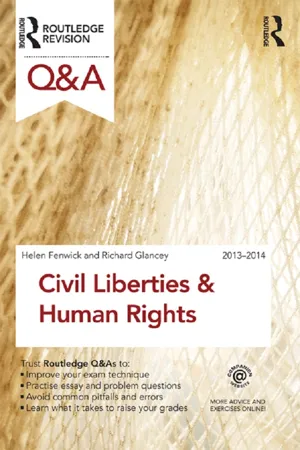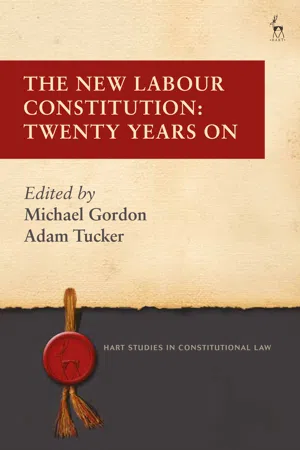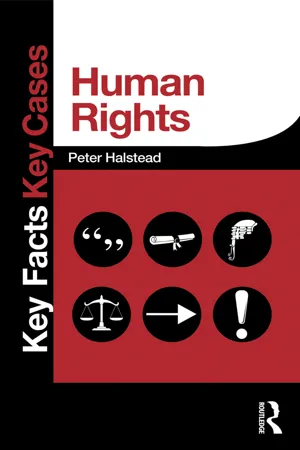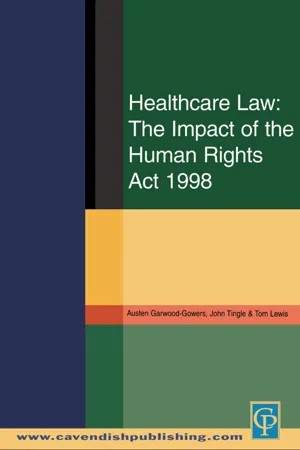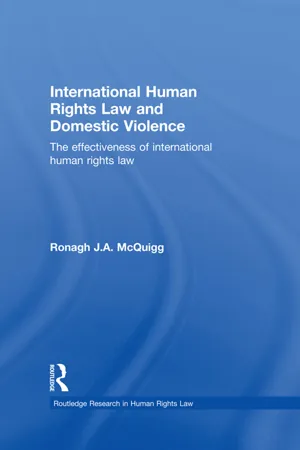Human Rights Act 1998
The Human Rights Act 1998 is a UK law that incorporates the rights and freedoms outlined in the European Convention on Human Rights into domestic legislation. It allows individuals to enforce their human rights in UK courts and requires public authorities to act in a way that is compatible with these rights. The Act has had a significant impact on the protection of human rights within the UK legal system.
8 Key excerpts on "Human Rights Act 1998"
- eBook - ePub
- Helen Fenwick, Richard Glancey(Authors)
- 2013(Publication Date)
- Routledge(Publisher)
...8 The Human Rights Act 1998 and the European Convention on Human Rights INTRODUCTION The Human Rights Act (HRA) 1998 has at the time of writing been in force for over fifteen years (it came into force in 2000), so it is possible to make an interim but fairly tentative assessment as to its efficacy in protecting human rights and freedoms in the UK. It affords further effect to a number of the rights protected under the European Convention on Human Rights. It remains a controversial piece of legislation; for example, in 2006 parts of the media blamed it for weakening the UK in its ‘war’ against terrorism, and for the early release of criminals. The criticism was misleading, since even if the HRA was repealed, the UK would remain bound at international level to abide by the European Convention on Human Rights. The Conservative Party has stated that its policy is to repeal the Act and to replace it with a ‘modern British Bill of Rights’, and indeed, in March 2011 it established the Commission on a Bill of Rights to specifically look into this matter. It is not possible at the time of writing to confidently predict what the conclusions of the Commission are going to be. One key difficulty preventing this is that its terms of reference were vague, merely saying they have been charged to investigate the creation of a Bill of Rights that incorporates and builds on the UK’s obligations under the European Convention on Human Rights, ensures that these rights continue to be enshrined in UK law, and protects and extends liberties. Their terms are therefore very vague and generic, which merely raises more questions than it is possible to answer at this moment in time...
- eBook - ePub
- Richard Glancey(Author)
- 2014(Publication Date)
- Routledge(Publisher)
...3 The Human Rights Act 1998 INTRODUCTION The Human Rights Act 1998 (HRA) does not provide the only means of protecting human rights and liberties in the UK, but it is the central piece of legislation in the field. The Act has now been in force for 14 years (it came into force in 2000), so it is possible to make an interim assessment as to its efficacy in protecting human rights and freedoms in the UK. It affords further effect to a number of the rights protected under the European Convention on Human Rights (ECHR). It remains a controversial piece of legislation; for example, in 2006, in a distorted and misleading fashion, parts of the media blamed it for weakening the UK in its ‘war’ against terrorism, and for the early release of criminals. Prior to the 2010 general election the Conservative Party stated that its policy was to repeal the Act if a Conservative Government was elected, and to replace it with a ‘British Bill of Rights’. Once the current Coalition Government was in place, this policy became problematic since the Liberal Democrats were pledged to retain the HRA. An independent Commission was appointed to examine the possibility of repealing the HRA and introducing a Bill of Rights in its place. The intention appears to be to ensure that a new Bill of Rights provides as much protection for human rights as the HRA does. It is likely that there will be a long period of consultation before such a Bill of Rights is put in place. If – which remains a matter of doubt – eventually a Bill of Rights is enacted, it would presumably protect the Convention rights that are currently protected under the HRA, so the respect in which it would sharply differ from the HRA is currently unclear. It might be made weaker than the HRA in certain respects – for example, s 3 HRA might be reproduced in the new statute, but modified to discourage judges from taking a radical approach to rendering statutory provisions compatible with Convention rights through creative interpretation...
- eBook - ePub
- Peter Halstead(Author)
- 2014(Publication Date)
- Routledge(Publisher)
...3 Human Rights Act 1998 AIMS AND OBJECTIVES At the end of this chapter you should be able to: Appreciate why there was a long time gap before the right of individual petition was made available in the United Kingdom Understand how traditional civil rights under English law have substantially been translated into modern human rights Explain how the European Convention is given ‘further effect’ in UK domestic law Demonstrate how European case law influences English law Understand how the substantive rights are interpreted by UK courts Appreciate that the doctrine of parliamentary sovereignty is preserved whilst at the same time the influence of the superior courts is enhanced 3.1 Introduction The Human Rights Act 1998 is one of the most important pieces of legislation enacted by Parliament in recent years and the key to understanding why that is, and how it operates, lies in the Council of Europe and the establishment and operation of the ECnHR discussed in Chapter 2. The first part of this chapter examines the background and considers various reasons why the Convention was not made part of UK domestic law when it was ratified by the UK on 8 March 1951. Growing pressure over the years eventually led to the Convention being ‘brought home’ by the 1998 Act, which came into operation on 2 October 2000 although by virtue of the Scotland Act 1998 the Convention was already operative in Scotland. The chapter goes on to provide a detailed analysis of the Act and how it operates, discussing the substantive sections and schedules together with examples of relevant case law. 3.1.1 A proud English tradition It took almost half a century for the Convention to become directly accessible as of right to individuals in the United Kingdom once all domestic routes had been exhausted and there are various suggestions as to why this was the case, some more convincing than others...
- eBook - ePub
The New Labour Constitution
Twenty Years On
- Michael Gordon, Adam Tucker, Michael Gordon, Adam Tucker(Authors)
- 2022(Publication Date)
- Hart Publishing(Publisher)
...3 The Human Rights Act 1998: Two Decades Swimming Upstream HÉLÈNE TYRRELL 1 I. INTRODUCTION T he Human Rights Act 1998 (HRA) was a cornerstone of New Labour’s constitutional reforms. By incorporating elements of the European Convention on Human Rights (ECHR) into domestic law, the HRA represented a voluntary surrender of government power and contributed to a significant rebalancing of the relationship between the individual and the state. Yet, two decades on, the HRA has excited such opposition that the electoral majority is courted with promises of its repeal. This chapter traces the contours of hostility towards the HRA, focusing on three themes: (i) New Labour’s own internal struggle over individual rights protections; (ii) the foreignness of the HRA; and (iii) complaints about judicial empowerment. All three themes evidence significant hostility towards the Human Rights Act, but it is argued that the unpopularity of the Act says more about its conception and neglect than it does about its value in the constitutional order. That the Act has survived a strong adverse tide is testament to its substance. By incorporating the ECHR into domestic law, the HRA has forced successive governments to protect unpopular minorities and to justify decisions by reference to convention rights. The Act has also cemented the importance of human rights protections in the constitutional landscape. II. THE UNLOVED NEW LABOUR FLAGSHIP: INTERNAL STRUGGLE AND POLITICAL FILICIDE The HRA was the flagship New Labour project...
- eBook - ePub
- Peter Halstead(Author)
- 2013(Publication Date)
- Routledge(Publisher)
...3 The Human Rights Act 1688 English Bill of Rights started to shift power from Crown to Parliament 1948 UN Declaration of Human Rights – a ‘Magna Carta for Humanity’ 1949 Treaty of London established the Council of Europe 1950 European Convention on Human Rights signed 1953 Ratification of Convention on reaching seven signatures 1966 Right of individual access to UK subjects with permission 1996 Consultation Paper Bringing Rights Home 1997 White Paper Rights Brought Home: The Human Rights Bill (Cm 3782) 1998 Human Rights Act Chapter 42 enacted 2000 Human Rights Act came into force 2 October 3.1 Genesis 1950–98 1 In 1950, the Convention established the first continental regional system under which individuals could seek protection against the actions of states and public bodies for which states were responsible. 2 It came into force in 1953 when seven states had ratified it but, although the UK was one of the first states to do so, it was and remained only an international treaty from the UK’s point of view until eventually its substantive provisions were given ‘further effect’ in domestic law under the Human Rights Act 1998. 3 It had been felt that English common law already provided sufficient safeguards through a variety of...
- Austen Garwood-Gowers, John Tingle, Tom Lewis(Authors)
- 2013(Publication Date)
- Routledge-Cavendish(Publisher)
...The biggest single change in this respect has been membership of the European Union (EU). 4 On the human rights front, the UK has, since 1951, bound itself to accept (subject to ‘derogations’ made under the Convention in specific cases) 5 the decisions of the European Court of Human Rights as a ‘final appeal court’ on matters concerning the rights protected under Articles of the European Convention on Human Rights (ECHR) and a number of its protocols, to which it is a signatory. A person in the UK can apply to have his or her case heard by the European Court of Human Rights if (s)he has exhausted the possibilities for getting it overturned within the domestic system of law (that is, the courts and, in criminal cases, the Home Secretary). Campaigns for a domestic Bill of Rights have been long standing. However, one of the concerns about implementing such a Bill has been the impact on sovereignty of the legislature. In the US system, sovereignty is compromised by the ability of judges to have the ultimate say, using the US Constitution to strike down legislative provisions. The Canadian and Hong Kong solutions avoid this by using a limited form of judicial entrenchment where the courts can override legislative provisions inconsistent with the legitimate protection of rights, subject to the legislature having the ultimate say. 6 The Human Rights Act 1998 (HRA), which brings the ECHR rights more or less wholesale into the fabric of English law, adopts the New Zealand stance of being an interpretative tool only. Under s 3 of the HRA, ‘primary and subordinate legislation’ must be read and given effect in a way which is compatible with the Convention rights. Provisions that cannot be interpreted in a manner consistent with those rights can be declared incompatible by the courts (s 4), but it is left up to Parliament as to whether it does anything about this incompatibility and whether it legislates in future in a manner consistent with rights...
- eBook - ePub
- Routledge(Author)
- 2013(Publication Date)
- Routledge(Publisher)
...The Human Rights Act 1998 Section 1 Incorporation of the Articles What Articles are omitted from HRA 1998? How have the courts interpreted the HRA? Positive and negative obligations Absolute and qualified rights Derogations This chapter looks in detail at the British ‘model’ of incorporation of the European Convention on Human Rights (ECHR), as implemented by the Human Rights Act (HRA) 1998. The chapter begins with the basic principles underlying the Act and then moves onto the most important sections of the Act, using illustrations where relevant. INTRODUCTION As noted in Chapter 3, the chosen approach to incorporation under the HRA 1998 is closer to the New Zealand model than the Canadian model. The Act adopts an ‘interpretative’ only approach and consequently the courts are not empowered to strike down incompatible primary legislation. The Lord Chancellor indicated that the intention was to learn from the experience of others but not to be constrained by it and that a ‘distinctively British approach for our British Parliament and British courts’ was to be adopted. There are a number of novel features in the British approach. The Lord Chancellor summed up the British model of incorporation as follows: The [Act] is based on a number of principles. Legislation should be construed compatibly with the Convention as far as is possible. The sovereignty of Parliament should not be disturbed. Where the courts cannot reconcile the legislation with Convention rights, Parliament should be able to do so - and more quickly if appropriate, than by enacting primary legislation. Public authorities should comply with Convention rights or face the prospect of legal challenge...
- eBook - ePub
International Human Rights Law and Domestic Violence
The Effectiveness of International Human Rights Law
- Ronagh J.A. McQuigg(Author)
- 2011(Publication Date)
- Routledge(Publisher)
...4 The Human Rights Act 1998 Could the United Kingdom courts rise to the challenge? The previous chapter outlined the potential held by the case law of the European Court of Human Rights on positive obligations to contribute to the fight against domestic violence. Although there are limitations on this potential, nevertheless the European Court has developed jurisprudence that could be used beneficially in this area. Governments have been repeatedly reminded that not only must they refrain from violating human rights standards, they also have duties to take positive steps to ensure that the rights of individuals are protected effectively. The European Convention has been incorporated into UK law by the Human Rights Act 1998. 1 However, could the UK courts rise to the challenge and use Convention rights to assist victims of domestic violence? This chapter will refer to the issues raised in Chapter 1 of the book. The issue of the public/private divide will be examined through a discussion of the horizontal effect of the Human Rights Act. The problem of conflicting rights is brought into focus by the difficulty of alleged perpetrators relying on human rights law. Problems surrounding the implementation of rights are highlighted by the issue of deference; the limits on what courts can achieve and difficulties surrounding socio-economic rights; and questions relating to the ability of law to deal with an ‘unseen’ crime...
